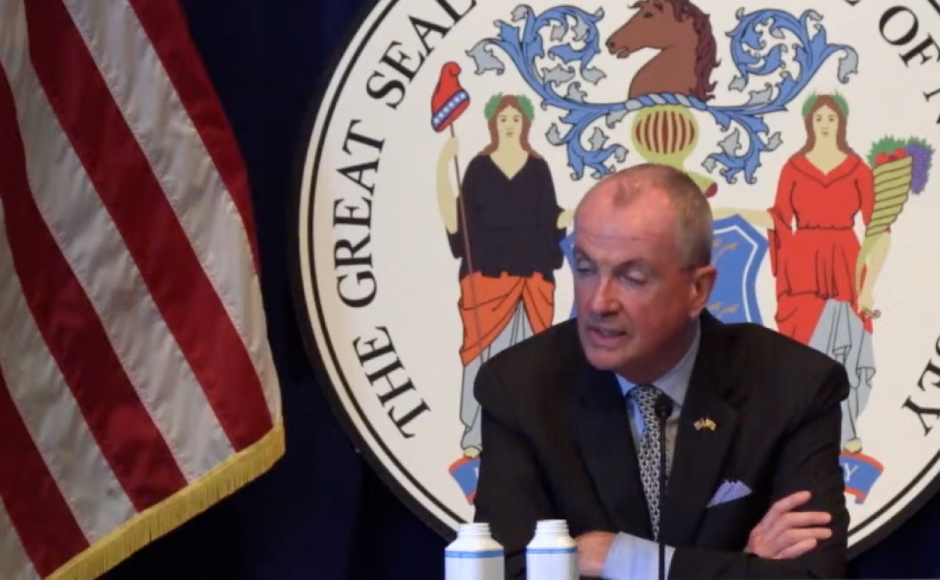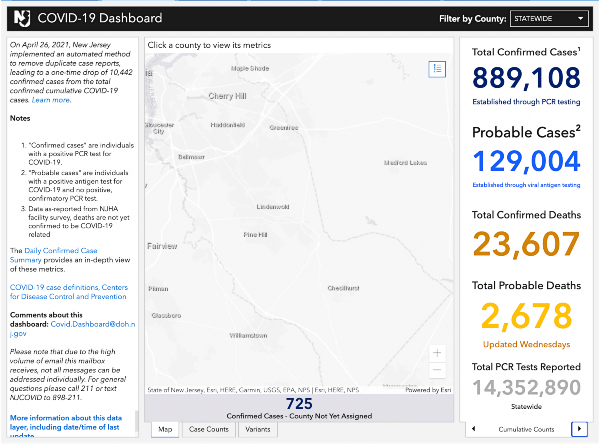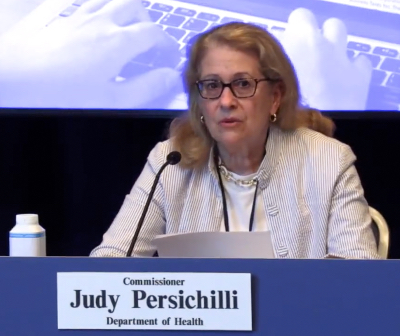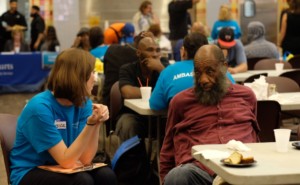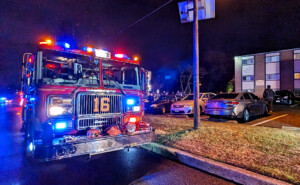Plus: Health Commissioner Judy Perschilli warns that adolescents and teens are still at risk of serious effects from the novel coronavirus, including needing hospitalization and intensive care.
By Matt Skoufalos | June 7, 2021
Another 165 New Jersey residents have tested positive for novel coronavirus (COVID-19), bringing the statewide total to 889,108 cases confirmed via polymerase chain reaction (PCR) testing, Governor Phil Murphy reported Monday.
New Jersey is also reporting 40 new COVID-probable cases based on antigen tests, bringing the statewide total to 129,004 positive antigen tests.
Antigen tests have a faster turnaround time than PCR tests—sometime within 15 to 30 minutes—but are less reliable at detecting active infection of the virus and more capable of reporting false positives.
Sadly, six more residents have perished from complications related to the virus, bringing the statewide, confirmed death toll to 23,607 lives lost during the pandemic.
In addition to those lab-confirmed fatalities, the state has acknowledged another 2,678 probable COVID-19-related deaths.
Since March 2020, 977 of every 100,000 New Jersey residents have been hospitalized with COVID-19, and 268 of every 100,000 have died from COVID-19-related complications.
More than 14.352 million polymerase chain reaction (PCR) tests for COVID-19 have been performed statewide, with a 10.111-percent positivity rate per 100,000 residents.
Wednesday’s briefing was the 200th of the pandemic, and New Jersey government officials were joined by White House Coronavirus Response Coordinator Jeff Zients, who offered some national perspective on the status of the pandemic.
At the beginning of 2021, the United States was averaging 184,000 new daily cases and 3,000 deaths, “and our daily lives in many ways had come to a halt,” Zients said.
“Today, just four-and-a-half months later, we’re down to fewer than 21,000 cases per day and deaths have dropped by 85 percent across the country,” he said, adding that New Jersey has observed a 93-percent decline in that same time period.
“The light at the end of the tunnel is getting brighter and brighter each day,” Zients said.
Rate of transmission (Rt) at 0.71, spot positivity lowest in South Jersey
The statewide average of COVID-19 spot positivity testing based on PCR test results stood at 1.06 percent June 3; in South Jersey, it was lowest, at 0.93 percent.
Rt, the variable that describes the seven-day, rolling-average, statewide rate of transmission of new COVID-19 cases, hit 0.71 on June 7.
Any Rt figure less than 1.0 means that each new COVID-19 patient is infecting fewer than one other person, on average, and the spread of the virus is decreasing.
Since its mid-April-2020 COVID-19 spike, the highest reported RT in New Jersey was 1.48, recorded August 1, 2020. Prior to artificially low, adjusted reports of 0.34 in the first week of May, the lowest in the past year was 0.62, recorded June 9, 2020. On May 21, 2021, it reached a new low, of 0.59.
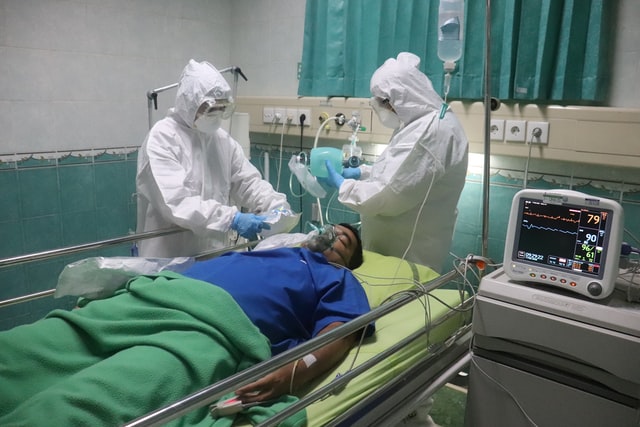
Simulated COVID-19 patient in a hospital bed. Photo by Mufid Majnun on Unsplash
Hospitalizations continue to decline
Throughout New Jersey, 431 people currently are hospitalized with a suspected or confirmed case of COVID-19, Murphy said.
It’s the fewest number of hospitalized patients in the state since late September 2020.
Among those hospitalized patients, 102 are in intensive or critical care, and 61 of the ICU and critical-care patients (59 percent) are on ventilators.
In New Jersey’s 71 critical care hospitals, 45 patients were hospitalized with COVID-19 yesterday, while 43 others were discharged.
LTC update
Across the state, long-term care (LTC) centers have reported 1,471 cumulative outbreaks of COVID-19, and 94 are dealing with an active outbreak. LTCs account for 55,981 infected patients and staff in New Jersey, or 6.2 percent of total cases.
That includes 32,758 residents and 22,223 staffers sickened by the virus, as well as 8,057 lab-confirmed resident and staff deaths (34 percent of the statewide confirmed total), with facilities self-reporting 144 staff deaths.
Of 624 veterans residing in three state-run homes, 456 residents have tested positive for COVID-19, and 156 have died from complications related to the virus. Three hundred veterans have recovered from the virus.
The facilities at Menlo Park, Paramus, and Vineland are staffed by 1,337 workers, one of whom is presently COVID-19-positive. The facilities have sustained two staff deaths related to the virus.
At state-run psychiatric facilities, 367 of 1,122 patients and 1,071 staff members have tested positive for COVID-19. Fourteen patients and eight staffers have died from complications related to the virus.
MISC cases and schools
To date, 127 New Jersey children aged 1 to 18 have been diagnosed with pediatric multisystem inflammatory syndrome (MISC)—one more than previously reported. Four of those cases were reported in Camden County, tied with Cumberland and Monmouth Counties for third-least in the state.
All those pediatric patients have tested positive for an active COVID-19 infection or the presence of COVID-19 antibodies, indicating exposure to the virus. No deaths have been associated with this syndrome in New Jersey, although several children have been hospitalized during their treatment for the illness.
Since August 1, 2020, 281 COVID-19 outbreaks encompassing 1,263 individual cases have been traced to schools in all 21 New Jersey counties. In Camden County, 18 outbreaks have been linked to 78 cases, sixth-most in the state.
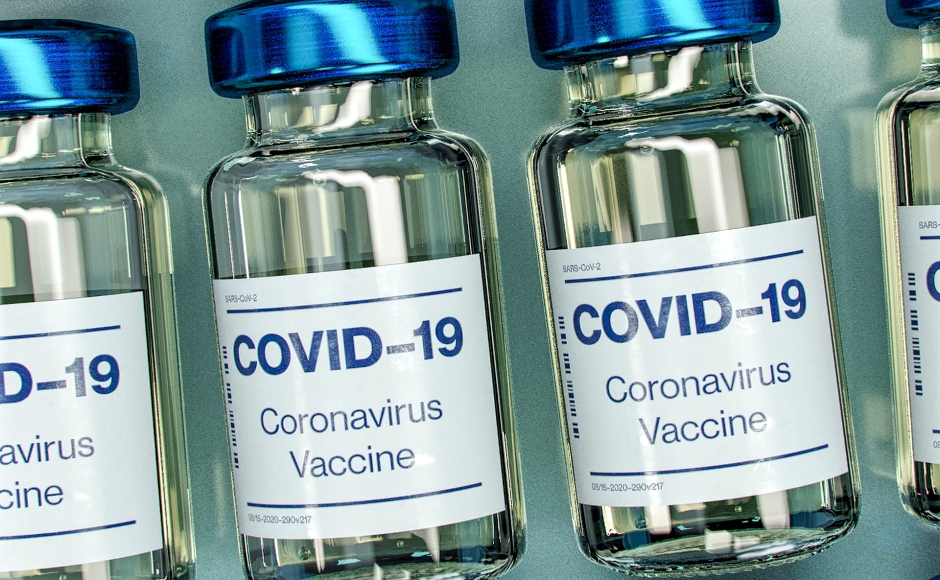
COVID-19 vaccine bottle mock-up. Photo by Daniel Schludi on Unsplash
Vaccination update: NJ surpasses 4M fully vaccinated people, 9M doses administered
Across New Jersey, 9.268 million COVID-19 inoculations have been administered.
Throughout New Jersey, 4.203 million people have been fully vaccinated in-state, having received either a one-shot formulation from Johnson and Johnson or both doses of the two-shot Pfizer or Moderna vaccines.
In Camden County, 489,024 doses have been administered; seventh-most in the state.
An estimated 357,974 New Jersey residents have received a vaccine dose outside of the state, of which 168,949 are estimated to have been fully vaccinated.
The first vaccines in the state were administered December 15, 2020; by February 8—55 days later—New Jersey had immunized its millionth resident. Twenty days thereafter, that count hit 2 million, and 3 million within two more weeks.
On March 29, New Jersey crossed the 4-million-dose threshold, and the state cleared 5 million doses over the weekend of April 10, 2021. Eight days after that, New Jersey hit the 6-million-dose mark. By May 3, 2021, the state had cleared 7 million doses administered, and two weeks later, it had surpassed 8 million doses. As of June 2, 2021, the state had cleared 9 million administered doses and 4 million fully vaccinated New Jerseyans.
According to New Jersey Health Commissioner Judy Persichilli, the percentage of New Jerseyans who have received at least one vaccine dose varies by age, with the oldest residents accounting for the bulk of inoculations:
- 88 percent of those 65 and older have received at least one vaccine dose, and 80 percent of them are fully vaccinated
- 74 percent of those aged 50 to 64 have received at least one dose
- 61 percent of those aged 30 to 49 have received at least one dose
- 49 percent of those aged 18 to 29 have received at least one dose
- 39 percent of those aged 16 to 17 have received at least one dose
- 21 percent of those aged 12 to 15 have received at least one dose
“Fully vaccinated people are much safer to engage in everyday life than unvaccinated people,” Murphy said, encouraging residents to “get vaccinated as soon as possible.”
NJ records 4,395 cases of variants of concern
Mutated offshoots of COVID-19, or “variants of concern,” continue to circulate throughout New Jersey; the state has traced 4,395 such cases to date.
The most common COVID-19 variant in the United States is the B.1.1.7, or “UK” variant, which has been detected in all 21 New Jersey counties. In total, 4,059 B.1.1.7 cases have been spotted in the state.
It’s associated with a 50-percent increase in COVID-19 transmission over earlier strains of the virus detected in New Jersey, and likely increased severity, based on hospitalization and case fatality rates, Persichilli has said.
New Jersey also has recorded 164 cases of the P.1 “Brazilian” variant, 11 reports of the B.1.351 “South African” variant, and 161 reports of the California variants B.1.427 and B.1.429.
The South African variant has demonstrated a 50-percent increase in transmission over other strains of COVID-19, and the California variants appear to show a 20-percent increase in transmission of the virus.
An unknown number of cases has also been reported of strain B.1.526, which has been reported as originating in New York.
Roughly 2 percent of positive samples are being tested for variants, said Dr. Ed Lifshitz, head of the New Jersey communicable disease service, adding that state officials would like to increase testing to better be able to trace those variants.
Outlier COVID-19 cases
In addition to commonly reported data points, New Jersey health officials are tracking COVID-19 outlier statistics, including the number of residents who’ve suffered repeat infections of the virus, and those who constitute “breakthrough” cases; i.e., those who test positive for the virus at least two weeks after having been completely vaccinated.
Persichilli said early reports indicate that breakthrough cases seem to be statistically small: just 0.02 percent of those who have been vaccinated against COVID-19 have contracted the virus afterwards.
NJ public health emergency ended
On Friday, Murphy signed legislation formally lifting the public health emergency in New Jersey; on Monday, however, the governor noted that the pandemic is still ongoing.
“We still have a vaccination goal to reach,” he said.
As noted in a press statement, despite retiring the emergency order, Murphy’s office is still authorized “to issue orders, directives, and waivers under the authority in the Emergency Health Powers Act,” for a number of purposes related to the pandemic, including:
- COVID-19 testing and vaccination efforts
- the allocation of health resources and personnel
- pandemic-related data collection, retention, sharing, and access
- the coordination of local health departments
- implementation of any CDC recommendations to prevent COVID-19 transmission
This authority lasts until January 11, 2022, and can be extended for 90 days with legislative approval.
Children still at risk for COVID-19
Persichilli spoke Wednesday about the need to be vigilant in protecting young children and adolescents from the impact of the pandemic until such time as they can be vaccinated.
She noted the new morbidity and mortality report from the CDC, which highlighted how the rate of hospitalization increased for those aged 12 to 15 in the first quarter of the year.
Nationally, one-third of those youngsters hospitalized required intensive care, and five percent required mechanical ventilation.
Of those, 30 percent had no underlying conditions presenting risk factors for COVID-19, “demonstrating that healthy adolescents are also at risk of contracting severe cases of the virus,” Persichilli said.
The health commissioner also noted that, demographically, two-thirds of those hospitalized adolescents and teens were Hispanic or non-Hispanic Black people, illustrating once again the healthcare disparities among ethnic minority communities throughout the pandemic and a need to circulate vaccines among those groups.
In New Jersey, 856 residents aged 5 to 18 have been hospitalized throughout the pandemic, and the rate of hospitalized children requiring ICU care has climbed from less than one percent to nine percent throughout its duration.


